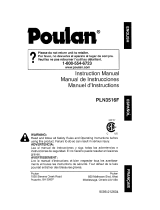
iMPORTANT SAFETY iNFORMATiON
A
_WARNING: When using an electric
chain saw, basic safety precautions
should always be followed to reduce
the risk of fire, electric shock, and
injury to persons, including the fob
lowing:
READ ALL INSTRUCTIONS.
Make sure you read and understand all
instructions in Important Safety Infor-
mation. Improper use of this chain saw
can cause severe injury or death from
fire, electrical shock, body contact with
moving chain, or failing wood.
BEFORE OPERATING SAW
1. Read and understand this owner's manual
before operating chain saw.
2. Watch what you are doing. Use common
sense. Do not operate saw when you are
tim&
3. Use chain saw for cutting wood only. Do not
use chain saw for purpose not intended. Do
not use for cutting plastic, masonry, etc.
4. Only welMnstructed adults should operate
chain saw. Never allow children to operate
chain saw.
5. Use only electrical voltage noted on model
plate of chain saw.
6. Use only extension cords marked for outdoor
use. See E,rtelzsion Cord Requir#mentx.
7. Do not operate chain saw
• while under the influence of alcohol, medi-
cation, or drugs
• in rain or in damp or wet areas
• where highly flammable liquids or gases am
present
• if saw is damaged, adjusted wrong, or not
fully and securely assembled
• if trigger does not turn saw on and oft. Chain
must stop moving when you release trigger.
Have fauky switch replaced by authorized
service center.
• while in a hut U
• while in tree or on a ladder unless trained to
do so
8. Wear snug-fitting clothes when operating
chain saw. Do not wear loose clothing or
jewelry. They can get caught in moving saw
chain.
9. Wear the following safety gear when operating
chain saw.
• heavy-duty gloves (wear rubber gloves
when working outdoors)
• steal-toed safety footwear with non-skid
soles
• eye protection such as safety glasses,
goggles, or face screen
• safety hard hat
• ear mufflers or ear plugs
• hair covering to contain long hair
• face or dust mask (if working in dusty
areas)
10. Before cutting, always provide the follow-
ing:
• clear work area
• secure footing
• planned retreat path from fafling tree
11. Inspecttreebefore cuttingdown.Make sumtfiem
am no dead limbs or branches that may f_dion
you.
12. To reduce the risk of electric shock, this saw
has a polarized plug (one blade is wider than
the other). This plug will fit in a polarized
outlet only one way. If the plug does not fit
fully in the oudet of your extension cord,
reverse the plug. If it still does not fit, a pola>
ized extension cord will be necessary. Do not
change the plug in any way.
WHILE OPERATING SAW
1. Stay alelt. Use common sense while operating
chain saw.
2. Keep work area dean. Cluttered areas invite
injuries.
3. Be aware of extension cord while operating
chain saw. Be careful not to trip over cord.
Keep cord away from chain and operator at
aH times.
4. Keep children, animals, and bystanders away
from chain saw and extension cord. Only
chain saw user should be in work area.
5. Do not cut down a tree unless you are trained
or have expert help.
6. If two or more persons perform bucking and
felling operations at the same time, provide
plenty of distance between operations. Provide
distance of at least twice the height of tree
being felled.
7. Secure wood you are cutting by using clamps
or chocks.
8. Grip chain saw firmly with both hands. Never
operate chain saw with one hand. Never use
hand guard as handle.
9. Keep finger off trigger until ready to make
cut.




















